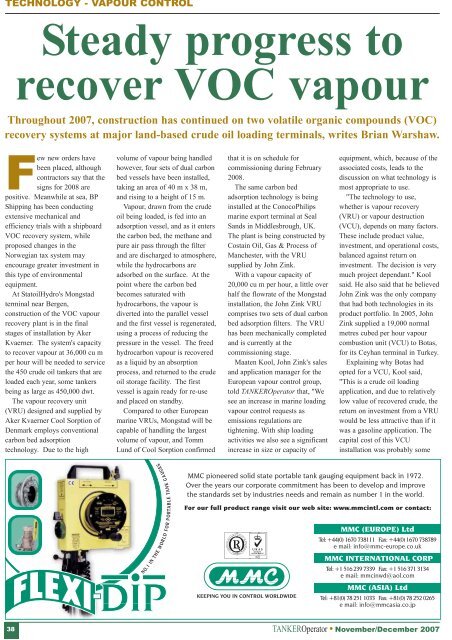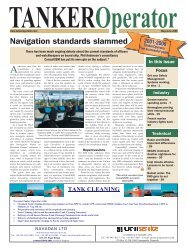You also want an ePaper? Increase the reach of your titles
YUMPU automatically turns print PDFs into web optimized ePapers that Google loves.
TECHNOLOGY - VAPOUR CONTROL<br />
Few new orders have<br />
been placed, although<br />
contractors say that the<br />
signs for 2008 are<br />
positive. Meanwhile at sea, BP<br />
Shipping has been conducting<br />
extensive mechanical and<br />
efficiency trials with a shipboard<br />
VOC recovery system, while<br />
proposed changes in the<br />
Norwegian tax system may<br />
encourage greater investment in<br />
this type of environmental<br />
equipment.<br />
At StatoilHydro's Mongstad<br />
terminal near Bergen,<br />
construction of the VOC vapour<br />
recovery plant is in the final<br />
stages of installation by Aker<br />
Kvaerner. The system's capacity<br />
to recover vapour at 36,000 cu m<br />
per hour will be needed to service<br />
the 450 crude oil tankers that are<br />
loaded each year, some tankers<br />
being as large as 450,000 dwt.<br />
The vapour recovery unit<br />
(VRU) designed and supplied by<br />
Aker Kvaerner Cool Sorption of<br />
Denmark employs conventional<br />
carbon bed adsorption<br />
technology. Due to the high<br />
38<br />
Steady progress to<br />
recover VOC vapour<br />
Throughout 2007, construction has continued on two volatile organic compounds (VOC)<br />
recovery systems at major land-based crude oil loading terminals, writes Brian Warshaw.<br />
volume of vapour being handled<br />
however, four sets of dual carbon<br />
bed vessels have been installed,<br />
taking an area of 40 m x 38 m,<br />
and rising to a height of 15 m.<br />
Vapour, drawn from the crude<br />
oil being loaded, is fed into an<br />
adsorption vessel, and as it enters<br />
the carbon bed, the methane and<br />
pure air pass through the filter<br />
and are discharged to atmosphere,<br />
while the hydrocarbons are<br />
adsorbed on the surface. At the<br />
point where the carbon bed<br />
becomes saturated with<br />
hydrocarbons, the vapour is<br />
diverted into the parallel vessel<br />
and the first vessel is regenerated,<br />
using a process of reducing the<br />
pressure in the vessel. The freed<br />
hydrocarbon vapour is recovered<br />
as a liquid by an absorption<br />
process, and returned to the crude<br />
oil storage facility. The first<br />
vessel is again ready for re-use<br />
and placed on standby.<br />
Compared to other European<br />
marine VRUs, Mongstad will be<br />
capable of handling the largest<br />
volume of vapour, and Tomm<br />
Lund of Cool Sorption confirmed<br />
NO.1 IN THE WORLD F O R P ORTAB L E TAN K G A UGES<br />
that it is on schedule for<br />
commissioning during February<br />
2008.<br />
The same carbon bed<br />
adsorption technology is being<br />
installed at the ConocoPhilips<br />
marine export terminal at Seal<br />
Sands in Middlesbrough, UK.<br />
The plant is being constructed by<br />
Costain Oil, Gas & Process of<br />
Manchester, with the VRU<br />
supplied by John Zink.<br />
With a vapour capacity of<br />
20,000 cu m per hour, a little over<br />
half the flowrate of the Mongstad<br />
installation, the John Zink VRU<br />
comprises two sets of dual carbon<br />
bed adsorption filters. The VRU<br />
has been mechanically completed<br />
and is currently at the<br />
commissioning stage.<br />
Maaten Kool, John Zink's sales<br />
and application manager for the<br />
European vapour control group,<br />
told TANKER<strong>Operator</strong> that, "We<br />
see an increase in marine loading<br />
vapour control requests as<br />
emissions regulations are<br />
tightening. With ship loading<br />
activities we also see a significant<br />
increase in size or capacity of<br />
equipment, which, because of the<br />
associated costs, leads to the<br />
discussion on what technology is<br />
most appropriate to use.<br />
"The technology to use,<br />
whether is vapour recovery<br />
(VRU) or vapour destruction<br />
(VCU), depends on many factors.<br />
These include product value,<br />
investment, and operational costs,<br />
balanced against return on<br />
investment. The decision is very<br />
much project dependant." Kool<br />
said. He also said that he believed<br />
John Zink was the only company<br />
that had both technologies in its<br />
product portfolio. In 2005, John<br />
Zink supplied a 19,000 normal<br />
metres cubed per hour vapour<br />
combustion unit (VCU) to Botas,<br />
for its Ceyhan terminal in Turkey.<br />
Explaining why Botas had<br />
opted for a VCU, Kool said,<br />
"This is a crude oil loading<br />
application, and due to relatively<br />
low value of recovered crude, the<br />
return on investment from a VRU<br />
would be less attractive than if it<br />
was a gasoline application. The<br />
capital cost of this VCU<br />
installation was probably some<br />
MMC pioneered solid state portable tank gauging equipment back in 1972.<br />
Over the years our corporate commitment has been to develop and improve<br />
the standards set by industries needs and remain as number 1 in the world.<br />
For our full product range visit our web site: www.mmcintl.com or contact:<br />
KEEPING YOU IN CONTROL WORLDWIDE<br />
MMC (EUROPE) Ltd<br />
Tel: +44(0) 1670 738111 Fax: +44(0) 1670 738789<br />
e mail: info@mmc-europe.co.uk<br />
MMC INTERNATIONAL CORP<br />
Tel: +1 516 239 7339 Fax: +1 516 371 3134<br />
e mail: mmcinwd@aol.com<br />
MMC (ASIA) Ltd<br />
Tel: +81(0) 78 251 1033 Fax: +81(0) 78 252 0265<br />
e mail: info@mmcasia.co.jp<br />
TANKER<strong>Operator</strong> � November/December 2007

















